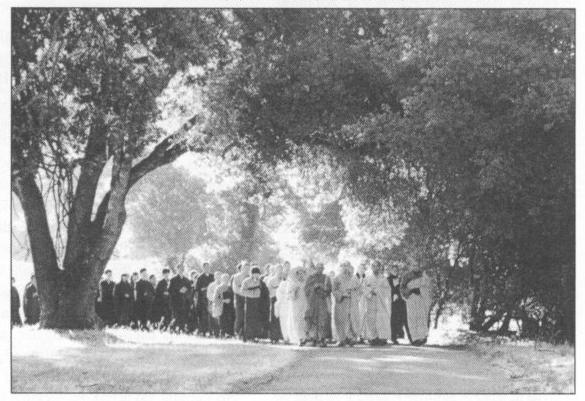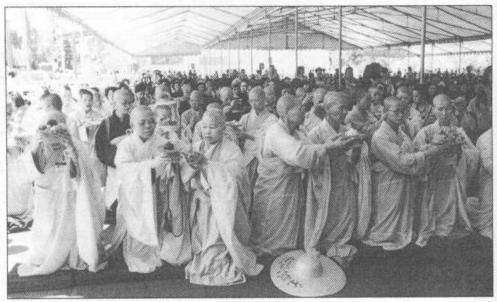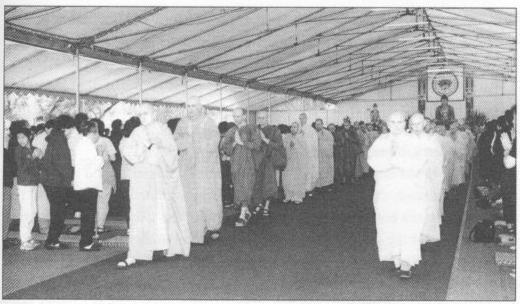萬佛聖城在六月三十日星期六與七月一日星期日連著兩天舉行盛大法會,紀念上宣下化老和尚涅槃六週年暨慶祝萬佛聖城成立廿五週年。法界佛教總會各分支道場紛紛組團前來與會,洛杉磯與長提的信眾分乘九輛大巴士浩浩蕩蕩於周六清晨抵達。聖荷西、舊金山的信眾包括越裔善信,包了六部大巴士參加盛會,加上其他地區國家的信眾,共有一千多人與會。
許多信眾來到聖城發現環境更加美化,萬佛殿前的景觀也有變化。早在法會前兩個月,聖城已經開始整修工作,首先在萬佛殿和法界佛教大學教室之間的廣場搭建起大帳篷,以容納數千信眾。帳篷內供奉釋迦文佛與文殊、普賢兩尊菩薩,雖是臨時搭建的代用佛殿,請了佛像之後,自有其莊嚴氣象。
廣場上原有的大佛像,請到祖師堂屋頂上,俯瞰著進人大殿的四眾弟子。廣場上的大香爐則移到祖師堂門外階前,與新安置的一對六呎高白色石獅子恰好鼎足三立,為萬佛殿前更添氣勢。
上人涅槃六週年法會在星期六早課後開始,首先傳八關齋戒,接著禮誦《華嚴經》,猶記上人在遺言中交待:「我走後你們可以誦《華嚴經》、念佛,或者一個七,或者七個七… …。」《華嚴經》念誦之後是千人拜願、繞塔至上人生前曾講課的無言堂,瞻仰釋迦牟尼佛舍利、虛老舍利與上人舍利,以及上人生前使用過的文物、法器、研讀的經典。上人墨寶與上人手澤物品,再次提醒大家,萬佛聖城的家風---「不爭、不貪、不求、不自私、不自利、不妄語」。接下來是千人傳供,一百零八道供品由傳供籌備小組與五觀齋堂、君康真素齋負責準備。每位參加傳供的人,都有機會親手捧著供品,向上人深深致上追思與懷念之意。上人的肉身雖然離開我們六年了,但其精神與教誨仍然與我們同在。
下午傳三皈五戒及行放生法會,並由上人弟子們講述上人行誼,晚課後持續進行,並由負責推動妙覺山計劃的法師與居士們,向在場千餘名信眾說明這項計劃的進展情況。
比丘恆來師說,「妙覺山計劃」於一九九零年經曼都仙諾郡政府以下水道設施、消防設施、水資源等無法配合此一大型之建設計劃為由,駁回申請。上人因此決定將原計劃之三十五公頃改為十八公頃,但鄰居仍有異議,歷經數次公聽會,至今尚未通過。
方丈恆律師則說,這次來了一千多人,不僅萬佛殿不敷使用,有些人還得借宿學生宿舍及學校過夜。而帳篷佛殿無牆無門,不足阻止宵小起竊心,無怪乎上人住世時便希望儘快興建妙覺山,以方便修行並進行宗教交流。
喜捨院當家比丘尼恆良師以畫龍點睛的方式,扼要說明上人對妙覺山計劃的高瞻遠矚。恆良師指出,妙覺山計劃不僅提供一個拜佛、參加法會的地方,而是上人有鑒於現代宗教已趨向儀式化,故提供一個地方讓佛教徒和其他宗教的信眾都能夠共同研究、修行。上人傳法來美,是一步步的弘揚佛法,奠下堅實基礎。正如修建聖城的山門,一磚一瓦都是上人帶領著弟子們親手砌就。所有發心參加的人將來菩提道上都有份。上人的氣,至正純陽,十分吉祥,而上人的心量更是心包太虛,量周法界。上人不只要為這一代的修行人,更為五百年,一千年後的修行人而建造妙覺山,並希望能重現千餘年前印度那爛陀寺的盛況,使妙覺山成為當代世界宗教、哲學的研究與修持中心。
法界聖城當家比丘尼恆貴師指出上人的心量很大,在一九七六年買下聖城後不久就想要擴大。當時上人開示,「萬佛城包含所有的宗教---基督教、天主教、回教。人願意來就來,願意走就走;不怕人多,也不怕人少。當時小齋堂只能坐500人,道源堂500人,人多就不夠用,所以再造一個大齋堂可容納1000人,這樣遇有大型法會至少兩千人可以同時用齋。齋堂只是小工程,還要蓋「華嚴正法堂」,容納萬人,還要造寶塔、大雄寶殿、大操場、放生池,要在萬佛城開天闢地,工程一天比一天多,所以要預為準備。至於經費,放心!我不向居士化緣,你們不要害怕。」恆貴師下結論說,上人希望在妙覺山的建設,不只給佛教徒,也給一切想研究真理的人。萬佛聖城前面這裡的七十多棟建築物所在地,就辦教育,包括中小學及大學。
在萬佛聖城住了十六年,對妙覺山建設計劃的來龍去脈知之甚詳的張福麟居士說,他前後看過七、八個設計理念。其實早在一九八二年萬佛聖城已提出妙覺山興建計劃的申請,但未通過。張居士以詼諧的口吻說:「申請的過程十分漫長,如果沒有健康的身體,壽數不夠,還無法蓋成!」雖是玩笑話,但背後說明的是:佛教事業是一條艱辛漫長的道路。張居士還記得,一九七六年初購下萬佛聖城時,每晚聽經只有五、六人,廿五年後的今天已有一百餘人,成長了二十倍,「照這樣的成長速度,二十年後晚間聽經將有兩千人,所以需要更大的地方,現在要蓋一萬人的大雄寶殿就是拆小廟,蓋大廟,把自己心裡的小廟放下,大家同心協力同修大廟。」張居士問在場大眾:「我們心裡能容納一萬人嗎?如果我們打開心量,像上人一樣,後山計劃一定蓋得成!」最後張居士透露,有一次上人講得非常清楚,新的大雄寶殿,不要說蓋在「後山」,「後山」不好聽,要說蓋在妙覺山,大雄寶殿只是萬佛聖城整體發展計劃的一部份。 來自聖塔•蘿莎的蔡以理建築師,則介紹了妙覺山計劃的最新版本建築設計。建築群坐北朝南,山門外有小溪環繞,寧靜優美。蔡建築師表示,目前這項計劃還在「環境影響評估報告」的審核階段。 胡果相居士解釋,妙覺山計劃何以經歷多年尚未動工,是因為公聽會一直未通過。她以洛杉磯地區一座著名的佛教寺廟在五百多次公聽會之後,才終於通過,獲准興建為例,鼓勵大家繼續努力。她又說 ,上人生前曾說大雄寶殿在「上面」已經有了,這回再度提出申請,只要有信心,一定做得成。
易果參居士特別提出,曼都仙諾郡的計劃委員會,將在今年十月投票決定是否通過妙覺山計劃的「環境影響評估報告與興建計劃」。她希望大家誠心祈求,迴向妙覺山計劃能順利通過。
七月一日星期日,萬佛聖城廿五週年紀念法會由清晨6:50朝山活動展開。聖城老友,基督教浸信會牧師兼曼都仙諾學院教授湯姆•麥克米倫也趕來參加朝山。他拜了四十餘分鐘,計四百多拜,雖然一身是汗,但身心舒暢。麥克米倫幽默地說:「我雖然也拜到了大殿,但跟恆實師從洛杉磯拜到萬佛城大殿的兩年九個月相較,我還缺兩年八個月廿九天二十三小時又二十分鐘,才能充分了解恆實師等人達到心智清朗的那種經驗。」
在朝山的同時,另有三百餘人隨著恆律師與恆良師一路誦觀世音菩薩聖號,走向妙覺山興建計劃預定地,在該地誦大悲咒。恆律師介紹時表示:「前人種樹,後人乘涼,妙覺山興建完成將可造福以後的修行人。」恆良師則強調,興建妙覺山的重點,不在於它是中國式或美國式,而在於它是法界眾生的歸依處。
來自洛杉磯的李親悟居士聽了大有體悟,他說,其實我們不只是為了自己的現世修建妙覺山,也不只是為了以後的修行人而建,他自認這輩子修行不一定能成就,將來還可能再度投胎娑婆世界,繼續在修行路上努力,因此,「事實上,很可能是為自己的未來而修建」。李親悟當眾大聲發願:「I'll come back(我將回來)。」
七月一日上午八時開始「走過歷史,展望未來」節目,由法界佛教青年會的代表上臺輪流報告,報告的同學都是培德中學的校友。貝慧學首先首先談到一位教她中文的尼師,曾給她看過一串念珠,說由原來的粗糙而色淡,變為光亮而色澤深。貝慧學當時的感想是:這位出了家的中文老師在誇耀自己的修行。但後來在經歷課業與人生的困難時,貝慧學才明瞭,當時那位老師要教她的是毅力與堅持。只要能堅持下去,事情終將逐漸順遂。
目前是史丹福大學研究生的吳適有,原是基督教浸信會的教友,於1991年來到聖城參加暑期班,當時不會說英語。初來時很緊張,因為聽說規矩很多,不能聽音樂會,也不能騎腳踏車到處遊逛,還要吃素,不能交女友。所幸暑期班很好玩,所以還不難適應。但是頭一年進萬佛殿時,每次拜下去口裡就直念「耶穌基督」。吳適有在培德中學念了四年,1995年畢業。他深深覺得這四年的經驗可以用「一
分耕耘,一分收穫」來形容。頭兩年,他參加的男校籃球隊輸得很慘,後來在瑜伽市和舊金山灣區,男校籃球隊越打越勇,屢屢為學校贏得獎盃,並被友隊封為 Buddhist Boys(佛教男孩)。在學業方面,同學們都進了想進的大學。(編按:吳適有在培德中學就讀期間,到曼都仙諾學院修課,獲得曼都仙諾學院的傑出學生獎。)
吳覺得在聖城求學與生活期間學到最珍貴的觀念是:—、人不免做錯事,要趕快改正。二、我們所做的事最後都會回到自己身上。例如:美國習於將污染工業設於開發中國家,以減少美國境內的染,但堪薩斯州的科學家發現,當地污染物竟來自中國戈壁沙漠。
曾追隨宣公上人多年,目前住持西雅圖越南禪寺的明照法師問吳適有:「你出去得到良好的教育,將來會回來教書,教育下一代嗎?」吳很快答覆道:「我自己想回來,也許很快,也許稍後,我會回來擔任老師或學校行政人員,或其他工作。我知道其他校友也有這種想法,但我不能代表他們發言。」(編按:培德中學校友林內華,於完成柏克萊加州大學學業後,曾返校擔任義務教師。)
五歲起就住進聖城的楊亭娜說,從小就常聽上人講經,但以前不了解如何聽上人的話,最近忽然了解,其實自己不僅是父母親的孩子,也是所有老師的孩子。大家都是一家人,上人是我們的大家長。上人的大願之一是聯合世界宗教,因為許多戰爭是因宗教而起。亭娜不久前隨同恆實師等人前往猷他州參加宗教聯合會議,由宗教聯合國主辦,對宗教之間應合作交流有深刻的感觸。
目前在麻省理工學院攻讀的陳彥君指出,法界佛教青年會已粗具雛形,特別是在加州柏克萊一帶有很多學佛的青年。彥君鼓勵在座的年輕人學佛,她說雖然今天發言的佛青會代表都是在聖城求學成長的,但並不只有在聖城長大的 年輕人才能學佛。
午齋後,再度開放無言堂瞻仰舍利,並傳三皈五戒,並繼續「走過歷史,展望未來」節目,遠道而來的善信則陸續起程回府。短短兩天的法筵盛會很快就到了尾聲,但萬佛聖城延續的家風,與發展的前景都已深深印在大眾心頭。-位住南加州的居士就表示,雖然坐車來回要二十小時,但她以後一定要多找機會,常來聖城。
如果人不殺生就會發慈悲心,不想再打仗;不偷盜就不會貪求、嫉妒別人的財物;不邪浮就不會有這麼多男人找女人,女人找男人的事情;不妄語,大家都會相信別人的話;不飲酒就不會有這麼多人醉酒而傷害自己或他人。
雖然如此,這個世界還是不夠完美,因為人還會出生、衰老、死亡,所以如果我們要有一個最完美的世界,那就快快念阿彌陀佛,求生極樂世界--這就是我最大的美夢了。 |
|
 |
※走向妙覺山計畫預定地
※Walking toward the proposed site of the International Institute of Philosophy and Ethics at Wonderful Enlightenment Mountain |
The City of Ten Thousand Buddhas held large Dharma assemblies for two consecutive days, Saturday, June 30th, and Sunday, July 1st, to commemorate the Sixth Anniversary of the Venerable Master's Nirvana and the 25th Anniversary of the City of Ten Thousand Buddhas, respectively. Groups from each of the branch temples of the Dharma Realm Buddhist Association attended the celebration. Nine buses carrying disciples from Los Angeles and Long Beach arrived early Saturday morning. Six buses brought devotees from San Francisco and San Jose, including Vietnamese Buddhists. Together with disciples from other areas and countries, there were over one thousand participants in all.
Many Buddhists coming to the Sagely City found the grounds more beautiful than before. The area in front of the Buddha Hall had been transformed. Renovation work had commenced two months before the event. First, a large tent with space for several thousand people had been erected in the plaza between the Buddha Hall and the Dharma Realm Buddhist University building. Images of Shakyamuni Buddha, Manjushri Bodhisattva, and Universal Worthy Bodhisattva gave the temporary "tent" Buddha Hall a dignified air.
 |
※傳供 The Passing of Offerings
|
The program for the 6th Anniversary of the Venerable Master's Nirvana began Saturday after morning recitation with the transmission of the eight precepts, followed by the recitation of the Flower Adornment Sutra in compliance with the Master's final instructions: "After I am gone, you all may recite the Flower Adornment Sutra and the Buddha's name for one week or up to seven weeks..." After the Flower Adornment Sutra recitation, the assembly of over a thousand people did universal bowing and then walked in line to the Wordless Hall, where the Master once taught classes, to behold the sharira (relics) of Shakyamuni Buddha, Elder Master Hsu Yun, and the Venerable Master, as well as the articles and Dharma instruments used by the Master, and the Sutras he had studied. The Venerable Master's brush calligraphy, as well as the articles he had used, remind everyone of the tradition of the City of Ten Thousand Buddhas: "No fighting, no greed, no seeking, no selfishness, no pursuit of personal advantage, and no lying." Next came the ceremony of Passing Offerings, with 108 kinds of offerings prepared by the Offerings Committee, the dining hall, and the Jyunkang Vegetarian Cafe. Each participant had a chance to hold the offerings in deep remembrance of the Venerable Master. Although the Master has physically been absent for six years, his spirit and his teachings are still very much present.
The afternoon program included a transmission of the Three Refuges and Five Precepts, a Liberation of Life ceremony, and talks on "The Life and Deeds of Venerable Master Hua" given by his disciples. These talks continued after the evening ceremony, with the Dharma Masters and laypeople in charge of planning the International Institute of Ethics and Philosophy (IIP&E) at Wonderful Enlightenment Mountain giving a progress report on this project to the audience of over a thousand.
Bhikshu Heng Lai Shi said that an earlier IIP&E plan was rejected by the Mendocino County government in 1990 on the grounds that the sewage system, fire fighting equipment, and water supply were inadequate for such a major facility. Consequently the Venerable Master reduced the area of the project from 35 hectares to 18 hectares. However, the neighbors still had issues, and after several public hearings, the project has still not been approved.
 |
※紀念法會 Memorial Ceremony |
Abbot Heng Lyu Shi commented that with over a thousand participants at this weekend's event, not only was the Buddha Hall too small, but some guests had to spend the night in the student dormitories or the schools. And the tent Buddha Hall, without walls or doors, was an open invitation to burglars. It's no wonder that the Venerable Master had been anxious to see the International Institute Philosophy and Ethics completed, so that spiritual practice and interfaith activities could take place.
Bhikshuni Heng Liang Shi, manager of Joyous Giving House, listed some essential points of the Venerable Master's aspirations and vision for the IIP&E at Wonderful Enlightenment Mountain. She said that the Master envisioned the Wonderful Enlightenment facility not only as a place to pay homage to the Buddhas and hold Dharma events, but also a place for Buddhists and those of other religions to study and practice together, for the Master saw religions in the modern world tending to overemphasize superficial rituals. In bringing the Dharma to the West, the Master proceeded step by step to propagate and lay a solid foundation for it, in the same way that he led his disciples to build the front gate, personally placing each brick by hand. Those who volunteer to help will all have a place on the Bodhi Path in the future. The Venerable Master has a pure and proper energy that is completely auspicious. His mind is so vast it could encompass the universe and the Dharma Realm. The Master wanted to build this Institute at the Wonderful Enlightenment Mountain not only for one generation of practitioners, but for practitioners 500 or 1000 years in the future. He also hoped that Wonderful Enlightenment Mountain's monastery could emulate the flourishing Nalanda Monastery in India from over a thousand years ago, becoming a center for religious and philosophical research and practice in the modern world.
Bhikshuni Heng Gwei Shi, manager of the City of the Dharma Realm, spoke of the Venerable Master's tremendous vision. Soon after the City of Ten Thousand Buddhas was purchased in 1976, the Master thought of expanding the existing facilities. He said, "The City of Ten Thousand Buddhas is a place for all Buddhists in the world, as well as all religious people, including Christians, Jews, Muslims. Anyone who wants to come may come, and anyone who wants to leave may leave. We are not afraid of there being many people, nor are we afraid of there being only a few. Our small dining hall could seat 500, and the Daoyuan Hall could seat 500. Now, with the new large dining hall with a capacity of 1000, we'll be able to seat 2000 people. This new dining hall is just a minor project. We also want to build a Flower Adornment Proper Dharma Hall to seat 10,000 people, as well as a jeweled pagoda, a Jeweled Hall of Great Heroes, a large athletic field, and a pool for liberating life. CTTB is blazing new trails. Each day there are more projects. Such expansion takes money, but don't worry, I won't solicit donations from you laypeople."
Heng Gwei Shi concluded, "The Venerable Master hoped to build the IIP&E not only for Buddhists, but for all who wish to study the truth. The seventy-some buildings in the front portion of the City will be devoted to education at the elementary, secondary, and university levels.
Upasaka Fulin Chang, who has lived at the City for 16 years and knows the ins and outs of the IIP&E project, said he has seen seven or eight different plans drawn up. Actually, the City submitted a plan for the facility as early as 1982, but it was rejected. Upasaka Chang quipped, "The process of getting approval takes so long that without good health and a long life span, one cannot hope to complete the project!" The underlying implications of this joke is that the work of Buddhism is difficult and long-drawn-out. Upasaka Chang remembers that back in 1976, when the City was first bought, only five or six people showed up for the evening Sutra lectures. Today, twenty-five years later, over a hundred people attend the evening lectures - a twenty-fold increase. "At this rate, there will be two thousand people at the Sutra lectures in twenty years' time, so we'll need a larger place. Our intent in building the Jeweled Hall of Great Heroes for 10,000 people is to expand our minds." Upasaka Chang asked the audience, "Are our hearts big enough to hold 10,000 people? If we can make our hearts as expansive as the Venerable Master's, the 'back project' will certainly become a reality!" Lastly, Upasaka Chang imparted this bit of information: Once the Master made it very clear that we should not say the new IIP&E is being built "in the back," for that doesn't sound good. Rather, we should say it is being built at Wonderful Enlightenment Mountain, and is only a part of the entire City of Ten Thousand Buddhas.
Mr. Elee Tsai, an architect from Santa Rosa, introduced the latest architectural plan of the IIP&E. The entire complex will face the south. A creek winds by the front of the main gate. The setting is tranquil and lovely. Mr. Tsai said that the entire plan is still awaiting approval of the Environmental Impact Report.
Upasika Guo-Xiang Woo explained that the reason the project had not begun construction after so many years was that it has not passed the public hearings. She encouraged everyone to continue their efforts, citing the example of a well-known Buddhist temple in Los Angeles that was only approved after more than 500 public hearings. She also quoted the Venerable Master's statement that the Jeweled Hall of Great Heroes already exists in the "above." Therefore, as long as our faith holds firm, our application will certainly be approved.
Upasika Guo-Tsan Nicholson said that the Mendocino Planning Commission will be voting in October to decide whether or not to approve the Environmental Impact Report and the building plans for the Institute. She hoped everyone would pray sincerely and dedicate the merit to the project's being approved without incident.
On Sunday, July 1st the 25th Anniversary Celebration of the City of Ten Thousand Buddhas began at 6:50 a.m. with people making full prostrations every three steps from the front gate to the Buddha Hall. Tom Macmillan, an old friend of the City as well as a Baptist minister and a professor at Mendocino College, arrived early to participate in the bowing. After making over 400 prostrations in forty minutes, he was sweating profusely but felt great both physically and mentally. "Although I bowed to the Buddha Hall, compared to Master Heng Sure's bowing journey of two years and nine months from Los Angeles to the CTTB Buddha Hall, I must still bow for two years, eight months, twenty-nine days, 23 hours and 20 minutes, beforeI can understand the peace and clarity of mind that Master Sure must have experienced."
Simultaneous with the bowing, more than three hundred people recited Guanyin Bodhisattva's name as they walked behind Heng Lyu Shi and Heng Liang Shi to the proposed site of the International Institute of Philosophy and Ethics at Wonderful Enlightenment Mountain, where they recited the Great Compassion Mantra. Heng Lyu Shi pointed out the site's boundaries and remarked, "Descendants enjoy the shade of trees planted by their forefathers. When completed, the International Institute of Philosophy and Ethics will be a blessing for future practitioners." Heng Liang Shi emphasized that the important thing is not whether the architecture of the IIP&E will be Chinese style or American style, but that it will be a refuge for all beings in the Dharma Realm.
Those words sparked a sudden awakening in Upasaka Qin-wu Li of Los Angeles, who commented that we are not building the IEP&E just for our own generation, nor merely for future practitioners. If we do not perfect our practice in this life, we may have to be reborn in this Saha world and continue to advance along the Path. Therefore, he concluded, "It's very likely that we are building this for our own future." He loudly declared before the assembly: "I'll come back."
At 8:00 a.m. "A Review of CTTB's History and Outlook for the Future" commenced with members of the Dharma Realm Buddhist Youth Group taking turns to report. The speakers were all alumni of Developing Virtue Secondary School. Sarah Babcock related that a nun who taught her Chinese once showed her some recitation beads that had started out coarse and light in color, but had become polished and deep in color over years of use. At that time Sarah thought her teacher was bragging about her own cultivation. Later, after encountering adversities in her studies and in life in general, Sarah realized that the teacher had been trying to teach her the values of perseverance and determination. If one perseveres, one will always bring things to a satisfactory conclusion.
Franklyn Wu, currently a graduate student at Stanford, had grown up Baptist and came to attend summer school at CTTB in 1991. At that time he could not speak English. He was very apprehensive when he first came, for he had heard about the numerous rules - one could not listen to music or ride a bike, had to be vegetarian, and could not have a girlfriend. Fortunately the summer camp was fun and not hard to get used to. However, the first year he lived at CTTB, he would recite "Jesus Christ" to himself every time he bowed in the Buddha Hall. Franklyn graduated in 1995 after four years at Developing Virtue Secondary School. He summed up those four years by saying, "You get as much as you put in." When he first joined the Boys School basketball team, it suffered agonizing losses. Later, however, they played better and better in Ukiah and the San Francisco Bay Area. They won numerous trophies and were nicknamed the "Buddhist Boys." Academically, students were all got into their universities of choice. [Editor's note: While studying at Developing Virtue Secondary, Franklyn Wu also attended classes at Mendocino College and received the Outstanding Student Award from the college.]
Franklyn mentioned several important concepts that he learned while studying and living at the City of Ten Thousand Buddhas. First, everyone makes mistakes, but we should be quick to correct them. Second, everything we do ultimately comes back to ourselves. For example, the United States habitually locates its pollution-generating industries in developing countries in order to reduce pollution in the U.S. However, scientists in Kansas have traced their local pollution to China's Gobi Desert.
Dharma Master Mingzhao, who had followed the Venerable Master for many years and now heads a Vietnamese Chan temple in Seattle, asked Franklyn, "Having left the City and received a good education, will you return to teach the next generation?" Franklyn replied quickly, "I personally do want to come back. It may be very soon or maybe after a while. I'd like to come back as a teacher or work in an administrative or some other capacity. I know other alumni who have the same idea, but I cannot speak for them." [Editor's note: Bonnie Lin, another alumna of Developing Virtue Secondary, returned to work as a volunteer teacher after completing her undergraduate studies at the University of California in Berkeley.]
Tina Yang, who has lived at the City since age five, has listened to the Venerable Master lecture Sutras ever since she was little, but never knew how to interpret the Master's words. Recently, it dawned upon her that actually, we are not only the child of our parents, but also the child of all our teachers. Everyone is part of one big family, and the Venerable Master is the head of that family. The Master's great vow is to unite the world's religions, for many of the wars in the world are religious wars. Tina Yang recently participated in a conference held by the United Religions Initiative in Utah, and she is very moved by the cause of interfaith cooperation and exchange.
Stacy Chen, currently a student at the Massachusetts Institute of Technology (MIT), pointed out that the Dharma Realm Buddhist Youth group is starting to take shape, especially since there are many young Buddhists in the Berkeley area. Stacy encouraged all the young people in the audience to study Buddhism. She said although the speakers of the day had all grown up and studied at the City of Ten Thousand Buddhas, CTTB's young people were not the only ones who could study Buddhism.
After the vegetarian lunch, the Hall of No Words was opened to display the sharira. There was another transmission of the Three Refuges and the Five Precepts, and the "Review of CTTB's History and Outlook for the Future" also resumed. Little by little, visitors from afar started on their return journeys. The two-day Dharma assembly soon drew to a close, yet the ongoing traditions and future prospects of the City of Ten Thousand Buddhas were deeply imprinted in everyone's mind. One layperson from southern California commented that although the round trip took twenty hours on the bus, she was determined to find opportunities to come more often. |